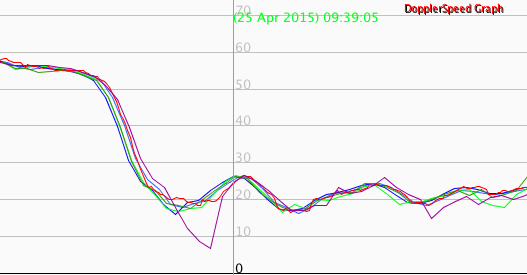So Manfred Fuchs, author of the widely used program GPSResults, has developed an app for Android phones for speedsurfing called GPSLogIt. It not only logs GPS data to a file for later analysis, but also shows results for the last and best run of the session, and even tracks:
As a geeky wanna-be speedsurfer, I had to try it, so I bought a cheap Android phone on Amazon.com (RCA M1 4.0 for $67), installed the GPSLogIt trial, and tried it out as soon as we got some wind. For comparison, I used my GT-31. Results were quite encouraging - most numbers were very close, although the long distance numbers and the alpha 500 where a bit lower with the phone. With the current trial (1.3), I was not able to read the numbers while sailing, or even when taking short breaks on the beach. Part of the problem was that I double-bagged the phone, using a ziplock bag inside a waterproof armband. I had to take the phone out of the armband at a shady place to see all the numbers and tracks. Future versions of the software will probably have a screen with bigger numbers that can easily be read while sailing.
After the initial promising results, a more thorough test was warranted. I decided to compare the phone with GPSLogIt to five GPS units I have: two Locosys GT-31s, two Canmore GP-102s, and the Flysight GPS. Here's a table of the results (raw data are here):
The GT-31 and the Flysight data include accuracy estimates (SDOP), so I included the +/- numbers as shown by GPSResults (for 5x10 seconds, I used a "typical" number for the 10-second runs).
All speed results obtained with the Android phone and GPSLogIt are within 0.6 knots of the numbers the other units gave. The 5x10 second numbers, which are often viewed as the most important top speed numbers, are within 0.1 knots, and well within the accuracy range of the GT-31 and Flysight units. However, the numbers for the nautical mile and especially alpha 500 are significantly lower. A close look at the doppler speed graph and the tracks provides some clues. Let's start with a large-scale view:
Mostly, the data for all 6 units are very close, but there are a few areas in the speed graph where the phone data drop below the other units. Here is a closeup:
There are several short areas in the track where the phone speed is artificially low; this explains why the long distance numbers are a bit lower than for the other units. It is fortunate that the error is on the low side - from the view of a competition, GPS units that understate true speed are acceptable, but units that overstate speed are not.
For the alpha, a look at the tracks when I drove around in circles is illuminating:
 |
| Blue: GT-31; red: Flysight; purple: phone & GPSLogIt |
Overall, the GPS accuracy of the phone I used was certainly acceptable, albeit not "perfect". Other phones may use different GPS chips and give different results, but several others have also reported decent accuracy with other phones. Nice to have another option for tracking your windsurfing sessions - and one that's less than $100, even if you buy a phone just for this purpose!



